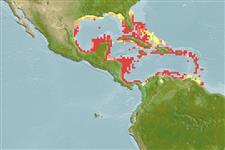Common names from other countries
Environment: milieu / climate zone / depth range / distribution range
Ecología
marino asociado a arrecife. Tropical; 32°N - 6°N, 99°W - 56°W
Western Central Atlantic: Florida (USA), Bahamas and throughout the Caribbean. Absent from the Gulf of Mexico.
Tamaño / Peso / Age
Maturity: Lm ? range ? - ? cm
Max length : 12.7 cm TL macho / no sexado; (Ref. 13442)
Adults pale yellow; usually darker dorsally; grayish yellow that pales ventrally. Iridescent blue dorsal-ventral lines on head, sometimes extending to the leading edge of pelvic fins. One distinct blue line encircles the orbit and extends ventrally on each side of the fish. Two black pigment spots are sometimes found on the snout region of the nares. A large black saddle on caudal peduncle, extending below the lateral line on each side of the fish. Pelvic fins yellowish, pectorals clear.
Mainly carnivorous (Ref. 13810). Has been reared in captivity (Ref. 35420).
Life cycle and mating behavior
Madurez | Reproducción | Puesta | Huevos | Fecundidad | Larva
Domeier, M.L., 1994. Speciation in the serranid fish Hypoplectrus. Bull. Mar. Sci. 54(1):103-141. (Ref. 26407)
IUCN Red List Status (Ref. 130435)
CITES (Ref. 128078)
Not Evaluated
Threat to humans
Harmless
Human uses
Acuario: Comercial
Más información
ReferenciasAcuiculturaPerfil de acuiculturaRazasGenéticaElectrophoresesheritabilidadEnfermedadesProcesamientoMass conversion
Herramientas
Special reports
Download XML
Fuentes de Internet
Estimates based on models
Preferred temperature (Ref.
115969): 25.6 - 28.2, mean 27.4 (based on 530 cells).
Phylogenetic diversity index (Ref.
82804): PD
50 = 0.5000 [Uniqueness, from 0.5 = low to 2.0 = high].
Bayesian length-weight: a=0.01778 (0.00680 - 0.04650), b=3.03 (2.80 - 3.26), in cm Total Length, based on LWR estimates for this (Sub)family-body shape (Ref.
93245).
Nivel trófico (Ref.
69278): 4.0 ±0.65 se; based on food items.
Resiliencia (Ref.
120179): Alto, población duplicada en un tiempo mínimo inferior a 15 meses (Preliminary K or Fecundity.).
Fishing Vulnerability (Ref.
59153): Low vulnerability (10 of 100).
